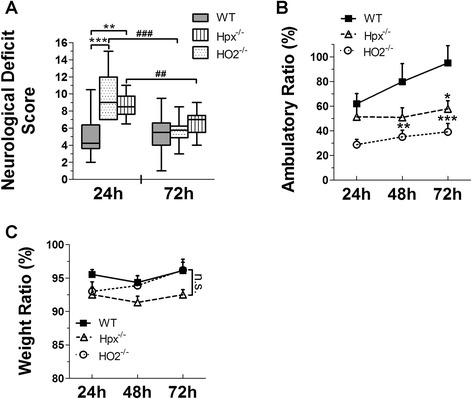Fig. 2.

Deleting Hpx and HO2 aggravates behavioral deficits after SFHb injection. Following SFHb injection, an investigator blind to the genotype assessed neurological function with neurological deficit score (a) and locomotor activity tests (b). All the mice showed recovery from the SFHb-induced injury 24 to 72 h after injection. The neurological deficit scores of HO2−/− and Hpx−/− mice are markedly higher than WTcontrols at 24 h, which suggests that neurological deficits were more severe in HO2−/− and Hpx−/− mice (a). In the locomotor test, the ambulatory distance of HO2−/− and Hpx−/− mice was significantly decreased compared with WT controls 72 h after injection (b). The body weight of all mice was decreased due to surgery; however, there was no significant difference among different genotypes after injection (c). Values represent means ± SEM, n = 10–12 per group. *P < 0.05, **P < 0.01, ***P < 0.001 compared to WT mice; ## P < 0.01, ### P <0.001 compared to 72 h, one-way or two-way ANOVA followed by Newman-Keuls or Bonferroni comparison tests except for neurological deficit scores, which were calculated by the nonparametric Kruskal-Wallis test followed by Dunn’s multiple comparison test
